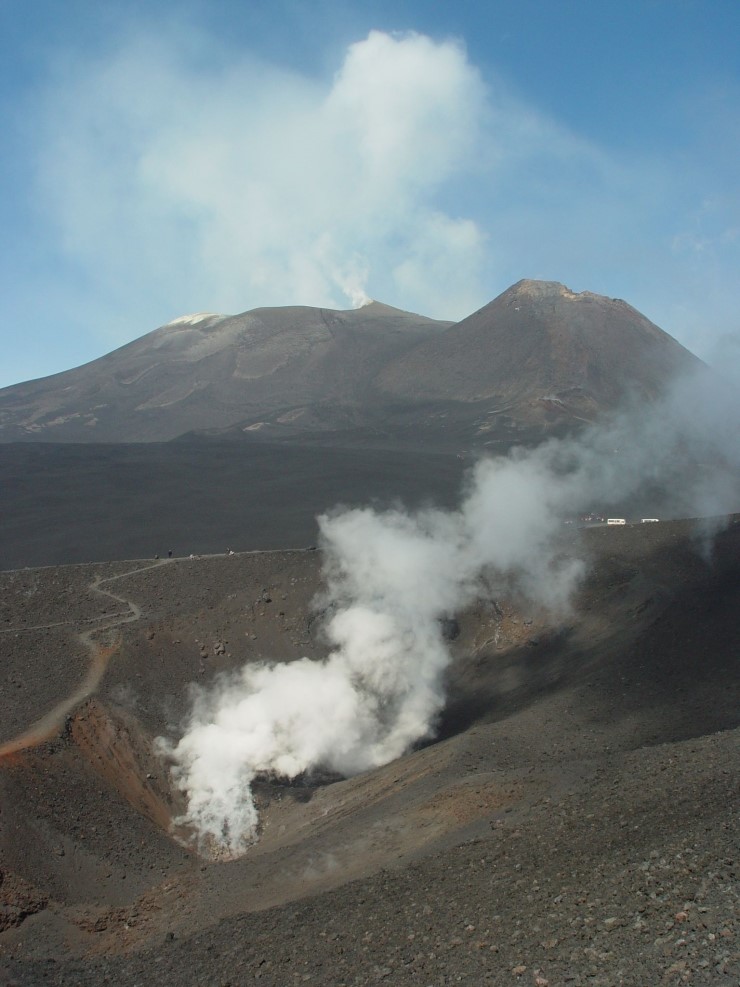바닷속으로 미끄러지고 있는 유럽 최대 활화산 에트나..."대재앙 붕괴' 전조인가? VIDEO: Mount Etna's Slide into the Sea Could Trigger a Catastrophic Collapse
Mount Etna's Slide into the Sea Could Trigger a Catastrophic Collapse
By Stephanie Pappas, Live Science Contributor | October 10, 2018 04:15pm ET
Gravity is pulling Mount Etna toward the sea, raising the possibility that the flank of the active volcano may someday suffer a catastrophic collapse.
Mount Etna is the most active volcano in Europe.
Credit: Wead/Shutterstock
바닷속으로 미끄러지고 있는 유럽 최대 활화산 에트나..."대재앙 붕괴' 전조인가? 중력이 에트나 화산을 바다로 끌어당기고 있어 활화산의 측면이 언젠가 치명적인 붕괴를 겪을 가능성을 제기하고 있다. 아직 붕괴가 임박했다는 징후는 없지만, 새로운 연구에 따르면 이탈리아 에트나 화산의 남동쪽 옆구리가 땅 위나 바다 아래에서 움직이고 있는 것으로 분석됐다 이러한 움직임은 경사 붕괴의 위험이 이전에 생각했던 것보다 높다는 것을 의미한다고 연구원들은 오늘 10월 10일 사이언스 어드밴스지에 발표했다. GEOMAR Helmholts의 해양 지질역학 연구원인 Morelia Urlaub는 "우리는 이 변화가 어떻게 작동하고 붕괴에 어떤 계기가 필요한지 더 잘 이해할 필요가 있다"고 말했다. [역사상 가장 파괴적인 화산] * 에트나 산 Mount Etna 에트나 산은 이탈리아 시칠리아 섬 동부 메시나와 카타니아 인근의 화산이다. 해발 3,350미터의 유럽에서 가장 높은 활화산이다. 알프스 산맥 남부 이탈리아에서 가장 높은 산이기도 하다. 에트나 산은 2013년 유네스코 세계유산에 등재되었다. - 위키백과 - 황기철 콘페이퍼 에디터 큐레이터 Ki Cheol Hwang, conpaper editor, curator |
edited by kcontents
There is no indication that such a collapse is imminent, but new research finds that the Italian volcano's southeastern flank is moving both above ground and under the sea. These movements mean that the risk of a slope collapse is higher than previously believed, researchers reported today (Oct. 10) in the journal Science Advances.
"We need to understand better how this transition works and what sort of triggers does it take for a collapse," study co-author Morelia Urlaub, a researcher in marine geodynamics at the GEOMAR Helmholtz Centre for Ocean Research in Kiel, Germany, told Live Science. [History's Most Destructive Volcanoes]
Eruptive Etna
Mount Etna is Europe's most restless volcano. This mountain has experienced active periods since at least around 6000 B.C. and is currently in an eruptive cycle that has been ongoing since September 2013, according to the Smithsonian Institution's Global Volcanism Program.

edited by kcontents
Researchers using satellite data and GPS measurements have also observed that Mount Etna's southeastern flank has been creeping seaward for at least 30 years. In March, scientists from The Open University in the United Kingdom reported that the slope moved an average of about a half-inch (14 millimeters) each year between 2001 and 2012 alone.
The debate, Urlaub said, has been whether this creep results from magma moving beneath and within the volcano or whether it results mostly from gravity. Mount Etna is constantly spewing material onto its slopes, she said, and gravity pulls that new material downward.
"That's common with these big volcanoes," Urlaub said. "They spread at the base."
Mount Etna also has its "feet in the water," Urlaub said. Its slopes continue below the Sicilian coast and into the Mediterranean. Until now, though, no one had measured how the flank was moving below sea level.
Submarine slipping
Using a network of seafloor sensors, Urlaub and her team measured how sound traveled from transponder to transponder every 90 minutes between April 2016 and July 2017. The time it took sound to travel reveals the distance between transponders, so the researchers could detect any changes in the seafloor over the study period.
They found that during an eight-day period in May 2017, a fault on the mountain's submarine flank shifted as much as 1.6 inches (4 centimeters). This was not an earthquake; the movement happened without a fault rupture or seismic waves, but rather as a gradual slip.
Eruptive Etna/National Geographic
edited by kcontents
The area where the researchers measured the slip is far from the magma chambers at the center of Etna, Urlaub said. That means that the movement did not result from magma rising within the volcano's subterranean chambers; instead, it's the inexorable work of gravity, which pulls on the entire slope above and below the water.
That's bad news for Etna's risk to human life, Urlaub said.
"We know from other volcanoes in the geological record that these have collapsed catastrophically and caused really, really big, fast landslides," she said, "and if these landslides enter the sea, they can cause a tsunami."
The chance of that happening at Etna can't yet be quantified, Urlaub said. Scientific observations of the mountain date back only a few decades, she said, and the whole history of Etna spans 500,000 years. More monitoring is needed to detect whether there are any changes in how the slope is moving and to estimate its risk of collapse, she said.
"There is a hazard," Urlaub said. "We just have to keep an eye on Etna's flank and how it is moving."
Originally published on Live Science.
https://www.livescience.com/63802-mount-etna-could-collapse.html?utm_source=notification
kcontents











